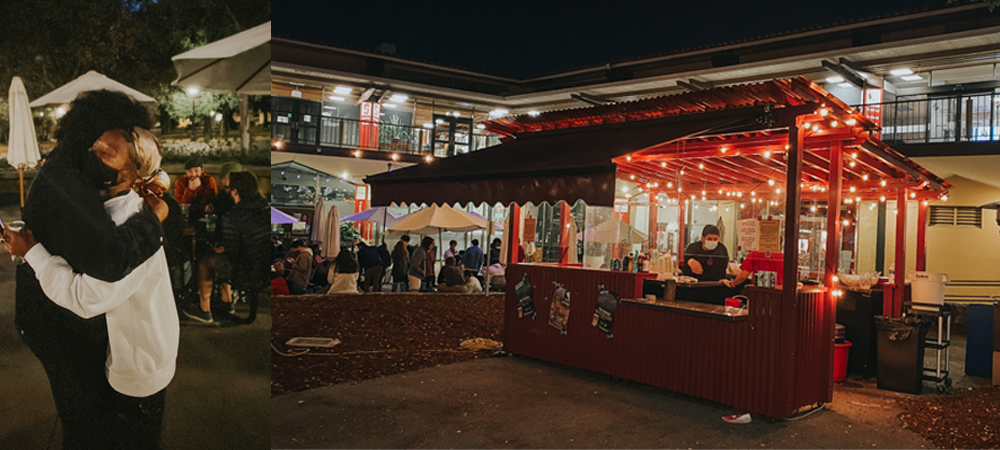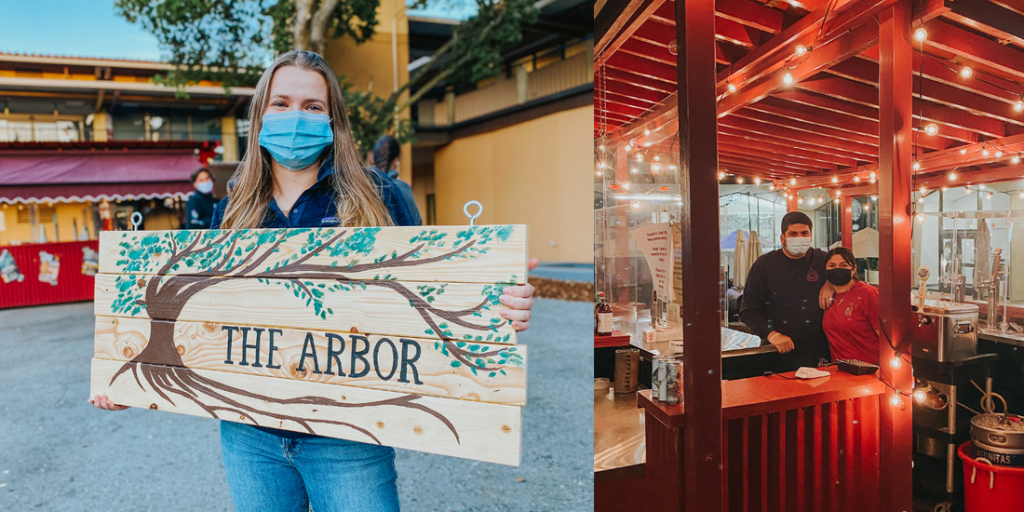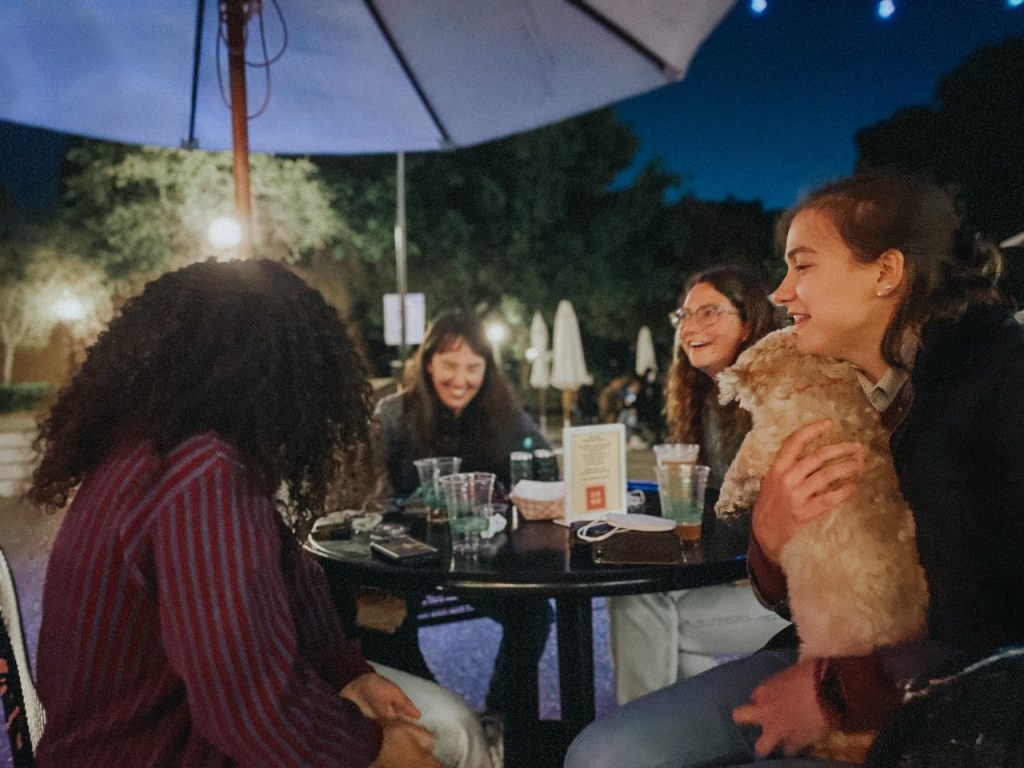As of May 25, 2021, about half of adults in the United States are fully vaccinated, according to the White House.
As vaccinations continue to ramp up throughout the country, cities are slowly reopening and there’s a growing sense of hope and optimism for what comes next.
Peninsula Press reporters, who are stationed across the country, provide snapshots of what life is like now more than one year into the coronavirus pandemic.
Aerial look at State Route 160 and the Port of Oakland
Ryder Kimball
I’m driving from San Francisco to Sacramento along Interstate 80 when unusually heavy traffic jams the road for miles. My phone recommends a detour: State Route 160. I crawl through the mess of cars and trucks until I reach the next exit, peeling off the highway as I eagerly push down on the gas pedal once again.
This stretch of 160 straddles the southern section of the Sacramento River as it winds through the small towns of Emmaton, Isleton, Ryde, and Walnut Grove before connecting with Interstate 5. Satellite images show a familiar rural scene: a patchwork of fields varying in shades of green occasionally interrupted by the river. But this drive feels anything but customary.
I pull over every few minutes and launch my drone to explore each facet of this area, which I’ll later learn is an alluvial plain. I fly up the Sacramento River and overlook the bridges that cross it at regular intervals. I explore the colossal, blinking telephone towers—covered with satellite dishes like barnacles—that rise up and loom over vast stretches of vineyards and farmland. I pull out my film camera and capture shots of people fishing in the slow moving river, bars with swinging doors, and houses shaded by willow trees.
I fly over a meadow of sheep nestled between a stretch of marshland and the San Joaquin River, a smokestack seen on the other side. I turn the camera around and let it hover on a line of slowly spinning wind turbines in the distance. I’m too absorbed with flying to notice a sheriff rolling up next to me to ask if I need help. He assumes I must be lost since I’m sitting on the hood of my car 5 miles down a dirt road. I show him the drone controller and he nods. “Let me know if you see a heifer, a farmer called in an hour ago and said one broke through his fence.” I tell him alright and he drives off.
The traffic has cleared up by the time I leave Sacramento so I take Interstate 80 all the way back home. Before crossing the Bay Bridge I pull off again and park by the loading docks. A set of large clouds has rolled in and they’re catching the light perfectly. I launch my drone and fly it over stacks of colorful freight containers. I film giant robotic arms delicately loading each onto a cargo ship. The drone spins around and I see a collection of ships anchored, patiently waiting their turn to dock. I’m leaning against a fence beside a particularly drab road but from my drone’s controller I watch the sunset illuminate the Bay from 400 feet in the air.
This year’s Supermoons
Kayci Lacob
The year’s first supermoon was also a “pink” moon, and it drew onlookers and admirers from around the world. Contrary to its name, the moon isn’t actually pink. It gets its name from the pink early spring time blooms of the Phlox subulate plant, known colloquially as “pink moss,” a plant native to eastern North America. During this first supermoon event, the moon was around 8% closer to the Earth than the average full moon and up to 30% brighter, all due to its place in orbit on an oblong-shaped orbit (known as the perigee, or the point on the moon’s orbit that is closest to Earth).
While each full moon, of which there are typically 12 in a year, has its own “traditional” name based on the way it is represented in the sky, its color and shape, and other details, only two of the full moons this year are considered to be supermoons by NASA (although there is debate about the legitimacy of two additional moons being included in this category). According to the Old Farmer’s Almanac and AccuWeather.com, moonwatchers and astronomy buffs alike can start preparing for 1 to 2 more supermoons this Spring and Summer (depending on how you classify a supermoon).
The Full Flower Moon is due to arrive on May 26, while the Full Strawberry Moon will show itself on June 24. We typically see between 2 to 4 supermoons a year and the visual differences are difficult to perceive beyond noticing a slightly more “noticeable” moon on the nights they present themselves, so why do these astronomical events still get us so excited? Native tribes and religious groups from all over the world have traditions and celebrations corresponding with supermoon events. There are customs rooted in spirituality and a history of giving oneself over to something larger than us and our life here on this planet. Sometimes it is hard not to feel small and insignificant when we stare out at something like the moon, but with phenomena like this we have the ability to revel in that smallness and appreciate our own trivialities. After the year our species had, this can be a helpful reminder to take a step back and ground ourselves.
Photos of the first supermoon on April 26, 2021 were taken in Woodside, CA using a Nikon D7200 at
approximately 11:30 p.m. to midnight. The composite image is photoshopped to show multiple moons layered on the same image. (Kayci Lacob/Peninsula Press)
Teton Park Road Opens for Spring
Syler Peralta-Ramos
Winter in Grand Teton National Park can be long and intense with an average of 14 feet of snow falling on the valley floor. As a result, the Park Service doesn’t bother to plow the central road known as the Teton Park Road. From November 1st until May 1 the 14.5 mile stretch of highway is inaccessible, yet the month of April brings a historic tradition to the park. In early April the Park Service plows the entire stretch of highway, but keeps it open only to non-motorized traffic until May. Historically, this month of transition was necessary to dry the highway before it could accept cars, but highway materials no longer need such treatment. Instead the month of April is kept as an off-season treat for the outdoor-loving locals to enjoy the park without the endless traffic that has become pervasive throughout the summer season.
Invasive species threatens Los Angeles kelp forests
Lilli Carlsen
An invasive species of seaweed is blooming off the coast of Los Angeles, CA. Sargassum muticum, or Japanese wireweed, is a type of seaweed that is native to Southeast Asia and Japan. Introduced to the North American coastline in the 1940s, this potent species has invaded over 3000km from Washington to Baja California.1
Kim White, president of the Cabrillo Beach Polar Bear Swim Club, says she noticed the fern-like seaweed about a month ago. White, who has been swimming at Cabrillo Beach daily for 21 years, last observed a similar invasion 5 years ago. “The water seems murkier,” says White, “It’s almost like there’s a dust on that stuff so we can’t see the neat fish we usually like to look at.”
Malia Carlsen, a fellow Polar Bear swimmer, agrees that the overgrowth of wireweed correlates with the recent decrease in underwater visibility. Carlsen noticed that the invasive species is becoming more abundant than the native kelp. “You can’t help but think that it is strangling the kelp,” she claims.
Photos: Sargassum muticum covers giant kelp in the water near the Cabrillo Beach Bathhouse on May 14, 2021. (Lilli Carlsen/Peninsula Press)
Pandemic Pastimes: Nurturing Yourself with Nature
Thomas Manglona II
Succulent shops are often an escape from busy streets and city centers. They serve as a picture-perfect oasis for people to visit as more people are vaccinated for COVID-19. The plant shops provide a reprieve to many people seeking to leave their homes but also bring life to their living spaces with plants and gardening as a pandemic pastime. It’s one of the more popular pandemic trends leaving some wondering if their plants will survive when they stop working from home.



Stanford’s The Arbor Reopens
Lilli Carlsen

RIGHT: Students gather at the Arbor beer garden at Stanford University for Thursday Trivia Night on April 22, 2021. (Lilli Carlsen/Peninsula Press)
On April 22, 2021, Stanford students flocked to the Arbor, an on-campus beer garden, for trivia night. The Arbor officially reopened after a year of closure due to COVID-19 restrictions. Now the Arbor offers drinks, snacks and fun events for students who comply with campus safety regulations.

RIGHT: Bartenders Jonathan Chipres, left, and Veronica Mejia serve a variety of beers, wine, and snacks. (Lilli Carlsen/Peninsula Press)
Q&A with Ari Wenokur:
After a year of separation, Arbor provides students with a space to reconnect. While some competed in a heated round of trivia, others mingled and relaxed at their tables. A few stood up to dance when their favorite song played. The noise level and upbeat mood were a shock to some patrons who were happily surprised to see such a good turnout.
Listen to the sounds of reconnecting.
“It felt so much more freeing than I could have imagined!
“After all this time it was really nice to be in a place that was so vibrant and where everyone was so happy to be healthy and safe finally and together again. A lot of the petty components of social interactions that can happen in college sort of melted away because we were all reminded of just how lucky we are to be together again,” said Maia Brockbank.

LEFT: Izzy Ampil holds a beverage cup. (Lilli Carlsen/Peninsula Press)
Many seniors who will graduate this quarter are thankful for the chance to celebrate the conclusion of their college years on campus among peers. Olivia Ames, who will confer both an undergraduate and graduate degree this June, enjoyed the night chatting at a table with four close friends and observing the energetic event.
“Considering that many of us are graduating and may not cross paths again it’s really joyous getting to just do something so casual and fun together that’s not related to classes or jobs,” said Olivia Ames

What’s next for New York City
Iman Floyd-Carroll
New York City: the “city that never sleeps” – indefinitely stopped – in March 2020 as the early epicenter of the COVID-19 pandemic.
As the harsh realities of the pandemic-era isolation edge closer towards distant memory with the presence of widespread vaccination across the nation and the invitation of warmer weather, New York City – and cities across the country – are returning to a tentative sense of “new normal.”
There’s a palpable tension in the city and an ever present question: ‘what’s next?’
That answer still looms on the horizon – but resilient as ever – New Yorker’s find solace in the ordinary and extraordinary of their everyday routines – in being and doing – as they must.
Signs of Spring: Animal Migrations in Grand Teton National Park
Syler Peralta-Ramos
As spring settles into the Jackson Hole Valley, the town settles into a period of temporary quiet as ski resorts, hotels and restaurants shut their doors as the landscape transitions to its summer beauty. Commonly referred to as “mud season”, tourists are often put off by the brown landscape that doesn’t look like the images on their postcards and instagram feeds. For many locals, however, beauty is found in the more subtle transitions that occur between April and May. Howling wind and bitter cold gives way to a chorus of migrating birds and “hot” 40 degree days.
As the snow recedes the landscape and the animals that call it home come to life, finally able to move with greater ease across the newly uncovered landscape. There is one species, however, which dominates this transition and that is the overwintering elk herd at the National Elk Refuge. Between 8,000 to 12,000 elk spend their winters on the refuge which directly borders the town of Jackson. Sitting between two buttes, the town of Jackson effectively blocks the migratory route of the elk, necessitating feeding efforts to keep the herd alive when snowpack covers the grasses below. Though the elk migration has been cut short by the town of Jackson, the movement out of the refuge each spring is a symbol of their resilience and the successful balance between humans, local culture and the local ecosystem.
Almost normal
Lilli Carlsen
April 7, 2021. Today was a weird day. I was out of coffee grounds, so I decided to pick up coffee from my favorite cafe nearby. Then, I realized that today marks two weeks since I received my second vaccine and the cafe just opened for dine-in. A few minutes later I found myself completely disoriented sitting inside a cafe working on my laptop and drinking a latte. It felt wrong. It felt wrong and almost repulsive to do what used to be my favorite relaxing activity. Something that used to bring me comfort now made me nervous and anxious as I tried to relearn how to interact with society after a year of quarantine.
Campus feels weird too. After 10 days of isolation at the beginning of spring quarter, undergrads are now allowed to meet up outdoors and hang out in small groups. The exact rules aren’t entirely clear yet, but it was clear that students were excited to interact again. Around 5 p.m., it seemed like everyone was outside to enjoy golden hour. Seeing people out and about makes campus feel alive again and reminds me why I love spring at Stanford. I met up with some friends for drinks and frisbee on Roble field. It felt like real college. However, there are small clues sprinkled throughout campus that remind me that we are not totally back to normal.
